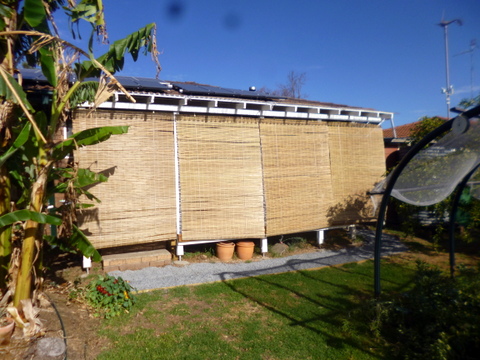Back in 2011 I put together an article about keeping the summer heat off the kitchen and dining room area, then in 2012 I added a sequel. Both of these articles concentrated on using a blind-type material to construct a barrier between the Western Sydney summer afternoon sun and the kitchen dining area, first with matchstick blinds and secondly with light coloured 90% shade cloth. But in the ten years plus since those were written I have put more effort into protecting the back (and other parts) of the house from the summer sun using a number of strategies. I thought it was time to share what I have done.
Kitchen Dining Area
To be fair, this is still a priority area, but a few years ago I built a back deck, and while the roof is clear corrugated polycarbonate roofing, it is covered with a double layer of 90% shade cloth and there are a series of bamboo blinds across the western side of the deck. This works pretty well to keep the sun off this strategic area of the house. For more details on how I constructed the deck (with the help of friends) there is a link here.
The Rest of the West
Of course the deck only covers six metres of the western side of the house ie the kitchen, dining room and laundry (partially). There is still another other six metres of the back of the house, consisting of the bathroom, toilet and third bedroom, which is currently my office. To cover this area we have a number of layers of vegetation – defence in depth.
The first (and most westerly) part of this defence is the banana circle. As well as providing bananas, using greywater and looking really cool, the banana circle provides afternoon shade for the laundry, bathroom and toilet.
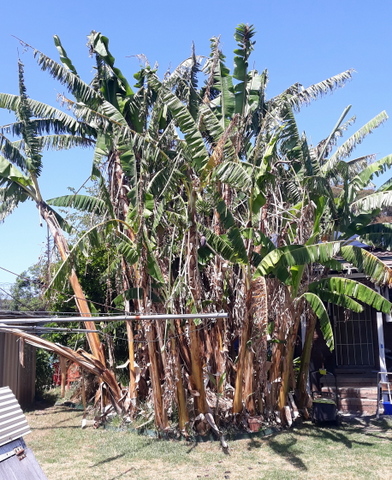
The banana circle
Closer to the house and a bit more northerly is the mandarine tree. It was originally located on the western side of the yard, but turned out to be where I wanted to put a shed, so I dug around the roots and pruned it back heavily then used a winch (and lots of pushing) to move it to its current position in front of the office/third bedroom. The mandarine tree provides shade mostly for the third bedroom/office back wall and part of the window.
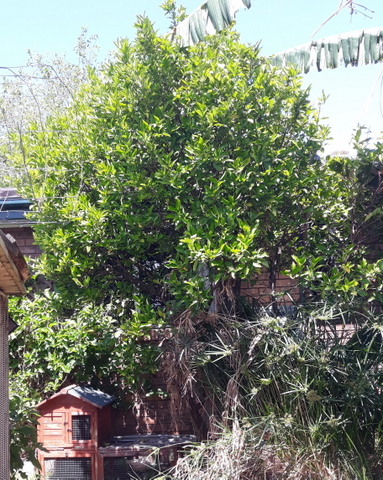
Mandarine tree, passionfruit vine on the window and papyrus from the constructed wetland
The northern part of the office/third bedroom window is covered mostly by a passionfruit vine and, depending on the time of year, the vine will creep over to the southern side of the window as well, eventually melding itself into the mandarine tree. It does die back somewhat in winter and is trimmed to allow some winter sunlight into the window, but it regrows each year.
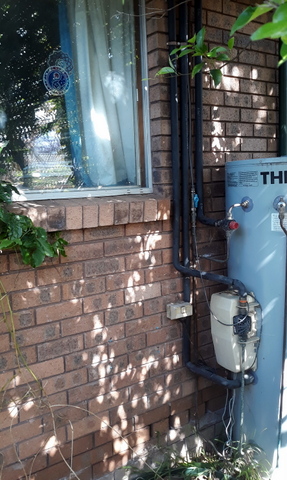
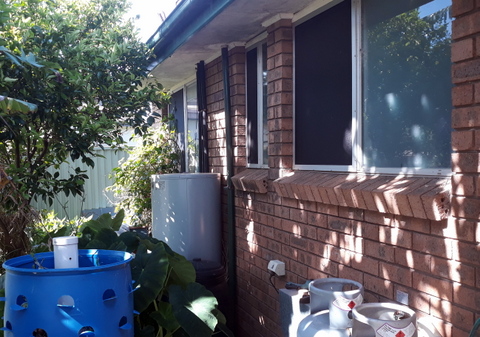
Shade from the assembled foliage on the back of the house
Between the banana circle and the mandarine tree and the house there is the constructed wetland. The constructed wetland grows large taro leaves and papyrus, which both provide some early afternoon shade on the lower part of the western wall off the house. The taro in particular dies back in winter and then comes back in spring.
The North East
The second bedroom/craft/spare room composes the north east corner of the house and gets sun cover in the morning and early afternoon from our mature mulberry tree. The mulberry tree covers the east face of the room, part of the roof and probably half of the northern wall of that room. The north wall of the house does also get some sun protection from the 5,500 litre rainwater tank and a couple of storage sheds that prevent the sun coming in direct contact with the north wall.
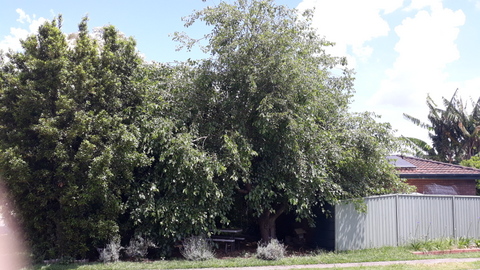
From the north
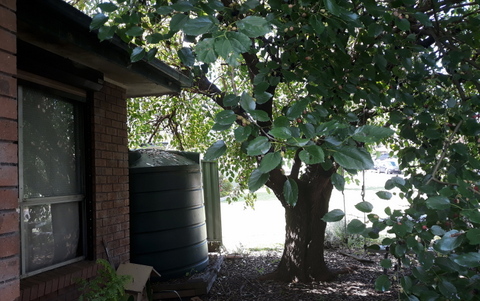
From the south showing shade provided on a summer morning
The East
We have quite a bit of foliage in the front yard including three large melaleuca alternifolia trees, a large bay tree, a large olive tree and several smaller fruit trees along the front boundary, but the foliage is high up so that we tend to get early morning sun on the house. We also have the fruit tree circle directly in front of the lounge room, but due to the angle of the house on the block, we usually get some morning sun on the lounge room windows in summer, but not so much in winter, when we do want it.
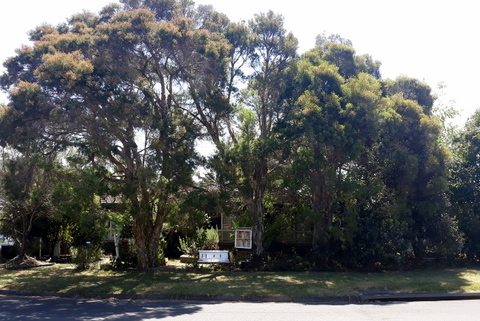
Melaleucas from the East
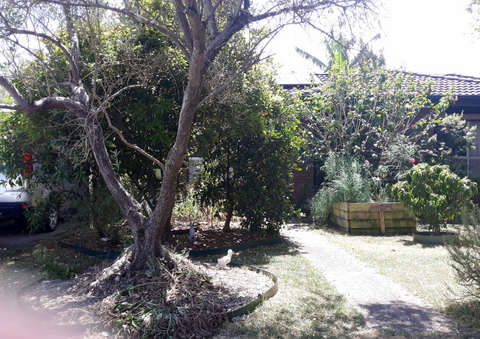
Fruit tree circle and the hibiscus (olive in the foreground)
Next to the house at the front door and part of the main bedroom wall, we have a large hibiscus and a moderately sized bottlebrush and these do provide some morning shade for the eastern wall of the house.
The South
Usually the southern wall of the house is not that much of a worry because it doesn’t get much, if any, sun. However, due to the skewed position of the house on the block, the south wall actually faces somewhat west of due south so that in late summer afternoons the sun would hit that wall. This is not a big issue for us, though, because the whole south wall is protected from the sun by the garage and so little sun falls directly on it.
Conclusions
So it can be seen that over time we have been able to put in place barriers so that the sun does not come into direct contact with the dark house brick and warm us up in summer. We have been able to do that, in the most part, with trees, shrubs and bushes that are productive in their own way, as well as providing sun protection for the house. This did not happen overnight. The mulberry tree on its own has probably been in place for over 30 years. Having said that, the banana circle and passionfruit vine have been working for us after only a couple of seasons.
I would love to say also that this ‘defence in depth’ was developed as a result of a coherent strategy and master plan. Unfortunately this was not the case and the whole thing has developed over a long time. Certainly it would have developed into an effective and productive sun barrier much more quickly if I had put a plan together first, and mistakes were made!
The banana circle was originally in the front yard in a totally inappropriate place. Where the banana circle and constructed wetland are now was originally the site of an unhappy and not very productive lemonade tree. Where the mandarine tree is now was a scrappy peach tree that acted as a very effective lure for fruit fly, which then went on to party in the veggie patches. It was only once I had done some study and hung around with some awesome permaculture bods that I was able to design things to be more productive and more effective.
I have made mistakes so you don’t have to! (That’s rubbish but I always wanted to say it!). My suggestion if you want to do something similar to what we have is –
- Do your research, read the books, join a permaculture group, and do a course if you can.
- Put a plan together, it will give you a chance to think about things as you put them down on paper before you put them down on your land (which is also a lot more work to change!).
- When you have a plan, give it a go and implement it! Even if it doesn’t work out it will hopefully still be fun and give you some good practical experience.
Good luck!



